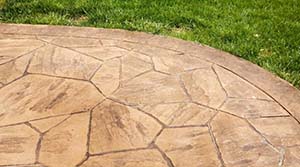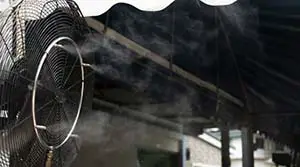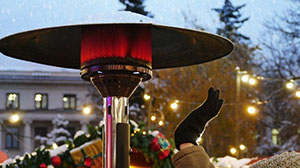
Propane patio heaters deliver heat to open areas like patios and decks. They are a great commodity to add to any outdoor space to enjoy the outdoors during the year’s cooler months. An important question that you should answer before purchasing a patio heater is how many you need.
Propane patio heaters come in various sizes with many different heating capabilities. Various heaters will cover another area.
As a general rule, 5,000 BTUs will cover 150 square feet, and 34,000 BTUs will cover 2,000 square feet.
However, when it comes to heating patios, it’s better to be safe than sorry and have too much heat rather than too little.
If you’re considering purchasing a patio heater and have questions similar to the one above, this article will help guide you. We’re going to take a look at safety and maintenance tips about propane heaters and the different options you have.
How Much Area Does a Propane Patio Heater Cover?
You should have one patio heater of at least 40,000 BTUs for every 1,500 square feet as a general rule. This rule depends on the quality and style of your heater and the heat setting you set it on.
It also depends on whether or not the patio you’re heating is covered or open to the elements. The above rule of thumb applies to enclosed spaces rather than open ones. If you have an open patio, the same heater will cover an area of only around 300 square feet.
Whether you have a propane heater or an electric one also matters regarding heat output. The amount of heat given off by each heater is similar, but electric ones give off slightly more than propane ones.
Do I Need Multiple Patio Heaters?
In some cases, you may need more than one patio heater to stay warm when it gets cold outside. Staying warm is especially important if you’re entertaining guests and have lots of people on your patio at once who all want to keep warm.
You can determine how many heaters you need based on the type of heater you’re thinking about buying and how big the area to be heated is.
Here is a step-by-step process of determining the number of heaters you need.
- Determine whether or not your patio is open or enclosed.
- Calculate the square footage of your patio.
- Decide on which propane patio heater or combination of heaters you’re going to purchase.
- Add up the total amount of BTUs you need and compare it to the heaters.
- Based on these calculations, you can determine the number of heaters you need.
The cool thing about patio heaters is that they come in various styles with different implementations. You can hang a couple of heaters and have several freestanding heaters.
Depending on your situation, this combination is necessary to properly disperse and spread out the heat you need to keep your patio warm.
How Close Can a Patio Heater be to the Ceiling?
A patio heater should be kept at least 1 to 1 ½ feet away from the ceiling for you and your guests safe while staying warm.
Patio heaters have a protective plate on the top that directs heat away from the ceiling and towards the ground.
Not only does this protect the ceiling from extreme heat, but it also provides more heat for the surface of the patio and its inhabitants.
Despite having this protective plate on top of the heater, a ton of heat still rises to the ceiling and can be a fire hazard. Putting your heater within a foot of the roof could result in too much heat hitting the ceiling. Too much heat against the roof could result in a fire.
Also, keep in mind that the more heat your patio heater gives off, the farther you should keep it from the ceiling. A foot is all the clearance you need for most smaller heaters to maintain safety.
If you have a larger heater that gives off more heat, you should keep it 18 to 24 inches away from the ceiling.
An added benefit of keeping your heater farther away from the ceiling is that it will be closer to the ground where the people need it.
As long as it isn’t so close to the patio itself that it becomes an obstruction or a burn hazard, the closer the heater is, the more effective it will be.
Heat rises because of how light it is, meaning that if your heater is too high, the heat will float away before it ever makes it to the ground.
What are the Benefits of Using a Propane Patio Heater?
Using a propane heater as opposed to an electric one has many benefits.
1. Flexibility & Versatility
Propane heaters offer the commodity of being used whenever and wherever you want. Natural gas heaters are permanent fixtures that cannot be moved and have a solid or flexible gas line connected to them.
Electric heaters are not as versatile because you can only operate them in places where electricity is available.
2. It is Easy to Install & Activate
Natural gas heaters are permanent or semi-permanent installments that require the skills of a professional HVAC technician.
On the other hand, propane patio heaters can be set up anywhere and don’t require professional assistance. As long as you safely connect the propane tank to the heater itself, you can set a propane heater up yourself.
3. Come in a Variety of Styles & Sizes
Propane heaters, like other heaters, come in a variety of sizes and styles, which allows you to spread heat evenly and totally throughout your patio area.
You can mix and combine different sizes of heaters to get the perfect amount of BTUs for your space. Propane heaters’ flexibility and variety are essential when staying warm in cold weather.
4. Instant Heat Once it’s Turned On
Electric heaters take time to heat up after turning it on, but propane heaters do not. The second you turn a propane heater on, the heat is instantaneous.
5. Clean Burning & Smoke-Free
Propane heaters produce the heat of a fire but without the smoke and messy ashes. If you have a patio full of people and objects, the last thing you want is irritating smoke getting into people’s eyes and lungs. If you’re having a dinner or lunch event, messy ashes will quickly derail any plans that you might have.
What Type of Patio Heater is Right For Me?
If you’ve decided to choose a propane patio heater as opposed to an electric or natural gas option, it’s time to decide on the style of heater you want. Here are the different types of propane patio heaters that you have to choose from.
1. Hanging Patio Heater
Hanging patio heaters are great for both small spaces and large ones. They conveniently hang from the ceiling a safe distance to not be a fire hazard but high enough that they’re out of the way of people and objects below.
You can hang them at different heights to accommodate whatever needs you might have.
The typical heating abilities of a hanging propane heater are anywhere from 10,000 to 30,000 BTUs. These heaters are also unique because they can be hung by different types of material, such as chains or metal straps, to give them an aesthetically pleasing quality.
If you have a beautiful patio, you don’t want to remove that beauty with an ugly heater. Hanging patio heaters are still portable, but not to the extent of a tabletop or freestanding heater.
2. Freestanding Patio Heater
This type of patio heater is perhaps the most popular. You will often find freestanding propane heaters at restaurants and outdoor bars. This type of heater is great because of its mobility and high heat output.
Freestanding patio heaters will stand upright and have a sleek look about them, along with a decorative base to conceal the propane tank inside.
Standing propane heaters often have a higher heat capacity than other heaters and operate at an average of 40,000 BTUs.
3. Mounted Patio Heater
A mounted patio heater does not offer the versatility of other more mobile heaters. Installing a mounted patio heater is also a little more complicated than other heaters, as you must attach it to a wall or ceiling securely enough that it will not be able to come loose.
Where you hang your mounted heater is entirely up to you, and you can always move it if you want to, but it will take a little work. Mounted heaters also come in sizes as small as a hanging heater or as large as a freestanding one, giving you many options.
4. Table-Top Patio Heater
Tabletop heaters are small, compact, and mobile, as depicted by their name. You can easily transport them from place to place and even from table to table if need be.
Because of how small they are, tabletop heaters won’t give off enough heat to warm an ample space. However, if you have a small or enclosed patio, a tabletop heater of 30,000 BTUs should be more than enough fire-power to stay warm.
Where is the Best Place to Have My Heater?
When deciding where to place your propane patio heater, it’s essential to factor in safety as well as practicality. You want your heater to warm up the most people, but not so close to anything or anyone that you will put them at risk.
Another critical thing to remember when using a propane heater is that they give off carbon monoxide. Carbon monoxide is deadly when inhaled for a prolonged period.
We do not recommend using a propane heater in an enclosed area, but you must place it near an open window or door if you do. The reason is that it will allow the deadly carbon monoxide fumes to exit the room.
You also don’t want to have a heater that will not do any good. The whole point is to keep people warm, but no good will be done if you have it too far away from the action.
However, safety is the most crucial concern with propane heaters. Please make sure they are at a safe distance from any people or objects and the walls and ceiling.
Important Safety & Maintenance Tips About Patio Heaters
Propane patio heaters are perfectly safe when used responsibly and correctly. Here are a few critical safety and maintenance tips to keep in mind when using a propane heater.
- Never use a propane heater in an enclosed patio without proper ventilation. Propane heaters give off deadly carbon monoxide fumes.
- Never leave your propane heater turned on without monitoring it.
- Take protective measures to make sure your patio heater doesn’t tip over. These heaters are specially designed not to tip over, but accidents can happen.
- Never have your heater covered while it’s in use.
- Keep several feet of clearance from any walls and ceilings to prevent a fire hazard.
- Keep your heater in a location that is away and out of reach of children.
- ALWAYS turn your propane off when not using your heater.
Maintenance Tips
- When you are not using your propane heater, it would be best to cover it up or store it inside. This will keep debris and other objects from finding their way into your heater’s inner workings.
- Make sure that your heater isn’t stored anywhere that it could get wet or damp.
- Clean the inside and outside of your heater at least once a year, but more often, depending on usage.
- If you live in windy areas, make sure that your heater is either tied down or stored inside to keep it from blowing away or tipping over.
Final Thoughts
Now that you know everything you need to know about how to choose the best patio heater for your needs, it’s time to go out and do it.
Take your patio space into consideration regarding its size and whether or not it’s enclosed. Also, consider the size and style of the heater that you prefer and the best way to heat your patio space.
Sources













